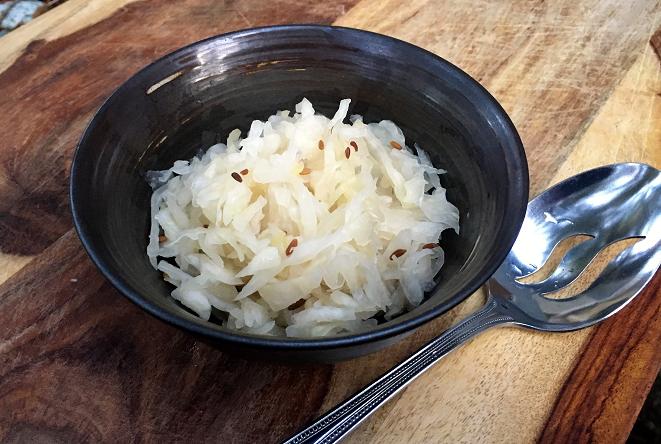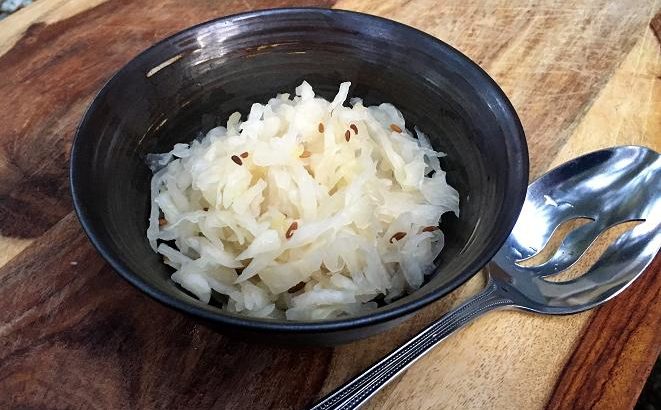 A full three quarters of a mightily dense cabbage head remains in the fridge so my Mason jar odyssey continues. First came the Korean kimchee, then the Mexican curtido and now I’m going to finish off this great green beast by hacking it up, salting and fermenting it as a classic Northern European sauerkraut.
A full three quarters of a mightily dense cabbage head remains in the fridge so my Mason jar odyssey continues. First came the Korean kimchee, then the Mexican curtido and now I’m going to finish off this great green beast by hacking it up, salting and fermenting it as a classic Northern European sauerkraut.
Now what we in America refer to with the blanket term of “sauerkraut” actually is part of a great Germanic-Scandanavian tradition of fermenting vegetables to keep during hard times thought to have originated in the Eurasian Steppes and spread by marauding tribes such as the Huns, Tartars and Mongols. Nowadays the name is synonymous with Germany, its culture and culinary traditions.
The big, dense cabbages of Northern Europe (of which mine were close cousins) are chopped, rubbed with salt and left to wilt in the same way I’ve started many a pickling project. The cabbage is then packed into a vessel and left to ferment in its own juices with the help of lactic acid bacteria that naturally hangs out the vegetable’s surface.
If all goes well over the course of a week or two the cabbage bubbles, breaks down, softens and sours into the beloved bratwurst sidekick we all know and love. At least that’s how it was portrayed by this exhaustive how-to article from The Kitchn and this other great article on kraut from Scientific America. Between the two you’ll learn EVERYTHING you’ll need to get fermenting… I did!
 Now I’d salted, smoked, brined, pickled and preserved just about every type of food that grows around the West Coast and even some that don’t, but I’d never fermented anything at home before. Mostly this was down to a lack of space and the misplaced notion that the process was rather smelly and decidedly non-cat friendly. This was my first dalliance with controlled rot.
Now I’d salted, smoked, brined, pickled and preserved just about every type of food that grows around the West Coast and even some that don’t, but I’d never fermented anything at home before. Mostly this was down to a lack of space and the misplaced notion that the process was rather smelly and decidedly non-cat friendly. This was my first dalliance with controlled rot.
I’m happy to report that making sauerkraut is not only very easy to do, takes up very little counter space if properly portioned and produces little to no funk at all. It only takes a couple minutes worth of weekend prep and then you kind of forget it for a while. Every so often I would remember it was there and wander over to press the cabbage down, marveling at the strange alchemy going on inside.
Sauerkraut (Fills 3x 500ml mason Jars)
Ingredients
- 5 ½ lbs (2 ½ kg) Green Cabbage (Sliced thin)
- 2 ½ Tbls. (30g) kosher Salt
- 1 Tbls. (7g) Caraway Seeds
Method
- Cleanse and sterilize two Mason Jars (one large one and a smaller jar that can easily fit into the mouth of the big one) in boiling water according to the manufacturer’s directions and set ‘em aside on a clean, dry surface to cool. Neither will require lids.
- Toss the cabbage into a large non-reactive bowl and massage the salt into it, making sure every bit of cabbage is seasoned. Set aside at room temperature for half an hour. The cabbage will wilt and begin expelling liquid. Mix in the caraway seeds.
- Pack the wilted cabbage into the large Mason jar along with any extra liquid and tamp it down with the bottom of the smaller jar. Once tightly packed, wrap the top of both jars with a tea towel and fasten it to the rim of the large jar with an elastic band.
- Leave the jars in a cool, dry place out of direct sunlight at room temperature and remember to press the smaller jar down every so often to keep the cabbage submerged in its liquid. Leave to ferment for a minimum of a week before tasting. The longer it ferments the stronger and more sour the flavour will become. I think the sweet spot is right around the 1 ½ week mark for this amount of kraut; after two weeks the liquid starts evaporating and leaving the cabbage vulnerable to mold. It can be left out to continue funkifying or it can go into the refrigerator where it will remain good for months.

Music To Can More Cabbage to:
Harvey Danger – King James Version

UPDATE: It’s been two and a half weeks and I’ve pulled the kraut from the kitchen table to the fridge. The Cabbage is perfectly crunchy-yet-soft and has a sweet ‘n sour quality unlike anything I’ve ever pickled. I don’t want the the cabbage to melt or ferment or whatever anymore than it already has… It’s perfect!